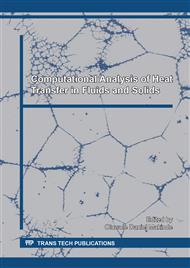[1]
R.B. Roemer, Engineering Aspects of Hyperthermia Therapy, Ann. Rev. Biomed. Eng. 1 (1999) 347–376.
Google Scholar
[2]
O. D. Makinde, On thermal stability of a reactive third-grade fluid in a channel with convective cooling at the walls, Applied Mathematics and Computation, 213 (2009) 170-276.
DOI: 10.1016/j.amc.2009.03.003
Google Scholar
[3]
H.H. Pennes, Analysis of tissue and arterial blood temperatures in resting human forearm, J. Appl. Physiol. 1 (1948) 93-122.
DOI: 10.1152/jappl.1948.1.2.93
Google Scholar
[4]
W. Wulff, The energy conservation equation for living tissues, IEEE Trans.-Biomed. Eng. 21 (1974) 494-495.
DOI: 10.1109/tbme.1974.324342
Google Scholar
[5]
H.G. Klinger, Heat transfer in perfused biological tissue, I. General theory, Bull. Math. Biol. 36 (1974) 403-415.
DOI: 10.1016/s0092-8240(74)80038-8
Google Scholar
[6]
M.M. Chen, K.R. Holmes, Microvascular Contributions in Tissue Heat Transfer, Ann. N. Y. Acad. Sci. 335 (1980) 137–150.
DOI: 10.1111/j.1749-6632.1980.tb50742.x
Google Scholar
[7]
R. C. Eberhart, A. Shitzer. E. J. Hernandez, Ann. NY Acad. Sci. 335 (1980) 107-32.
Google Scholar
[8]
K. R. Diller, J. W. Valvano, J. A. Pearce, Bioheat Transfer. The CRC Handbook of Thermal Engineering. Ed; Frank Kreith, CRC Press, (2000).
DOI: 10.1201/9781420050424.ch4.4
Google Scholar
[9]
J.W. Durkee Jr., P.P. Antich, Exact solutions to the multi-region time-dependent bioheat equation with transient heat sources and boundary conditions, Phys. Med. Biol. 36 (1991) 345-368.
DOI: 10.1088/0031-9155/36/3/004
Google Scholar
[10]
J. Liu, X. Chen, L.X. Xu, New thermal wave aspects on burn evaluation of skin subjected to instantaneous heating, IEEE Trans. Biomed. Eng. 46 (4) (1999) 420-428.
DOI: 10.1109/10.752939
Google Scholar
[11]
O. D. Makinde, T. M. Acho, P. Sibanda, E. M. Lungu, The bio-mechanics of atherosclerosis development.CAMES, 10 (1) (2003) 23-31.
Google Scholar
[12]
J. Prakash, O. D. Makinde, Radiative heat transfer to blood flow through a stenotic artery in the presence of erythrocytes and magnetic field. Latin American Applied Research, 41 (2011) 273-277.
Google Scholar
[13]
J. Liu, L.X. Xu, Estimation of blood perfusion using phase shift in temperature response to the sinusoidal heating at the skin surface, IEEE Trans. Biomed. Eng. 46, (2001) 1037-1043.
DOI: 10.1109/10.784134
Google Scholar
[14]
R. J. Moitsheki, O. D. Makinde, Some invariant solutions for a microwave heating model. Applied Mathematics and Computation, 191 (2007) 308-311.
DOI: 10.1016/j.amc.2007.02.088
Google Scholar
[15]
Z.A. Deng, J. Liu, Analytical study on bioheat transfer problems with spatial or transient heating on skin surface or inside biological bodies, ASME J. Biomech. Eng. 120 (2002) 638-649.
DOI: 10.1115/1.1516810
Google Scholar
[16]
J. Liu, Preliminary survey on the mechanisms of the wave-like behaviors of heat transfer in living tissues, Forsch. Ingenieurwesen/Eng. Res. 66 (2000) 1-10.
DOI: 10.1007/s100100000031
Google Scholar
[17]
N. Ma, S. Jiang, H. Li, X. Zhang, Analysis of non-flourier effect and laser-induced thermal damage of laser-irradiated layered human skin tissue, Space Med. Med. Eng. 16 (2003) 133-137.
Google Scholar
[18]
Z.S. Deng, J. Liu, Mathematical modeling of temperature mapping over skin surface and its implementation in thermal disease diagnostics, Comput. Biol. Med. 34 (2004) 495-521.
DOI: 10.1016/s0010-4825(03)00086-6
Google Scholar
[19]
W. Shen, J. Zhang, F. Yang, Modeling and numerical simulation of bioheat transfer and biomechanics in soft tissue. Math. Comput. Modell. 41 (2005) 1251-1265.
DOI: 10.1016/j.mcm.2004.09.006
Google Scholar
[20]
T.C. Shih, P. Yuan, W.L. Lin, H.S. Kou, Analytical analysis of the Pennes bioheat transfer equation with sinusoidal heat flux condition on skin surface, Med. Eng. Phys. 29 (2007) 946-953.
DOI: 10.1016/j.medengphy.2006.10.008
Google Scholar
[21]
F. Xu, K.A. Seffen, T.J. Lu, Temperature dependent mechanical behaviors of skin tissue, IAENG Int. J. Comput. Sci. 35 (2008) 1-13.
Google Scholar
[22]
P. Yuan, H. E. Liu, C. W. Chen, H. S. Kou, Temperature response in biological tissue by alternating heating and cooling modalities with sinusoidal temperature oscillation on the skin, Int. Commun. Heat Mass Transf. 35 (2008) 1091-1096.
DOI: 10.1016/j.icheatmasstransfer.2008.05.012
Google Scholar
[23]
J. Okajima, S. Maruyama, H. Takeda, A. Komiya, Dimensionless solutions and general characteristics of bioheat transfer during thermal therapy, J. Therm. Biol. 34 (2009) 377-384.
DOI: 10.1016/j.jtherbio.2009.08.001
Google Scholar
[24]
H. Ahmadikia, R. Fazlali, A. Moradi, Analytical solution of the parabolic and hyperbolic heat transfer equations with constant and transient heat flux conditions on skin tissue, Int. Commun. Heat Mass Transf. 39 (2012) 121-130.
DOI: 10.1016/j.icheatmasstransfer.2011.09.016
Google Scholar
[25]
K. Das, S.C. Mishra, Estimation of tumor characteristics in a breast tissue with known skin surface temperature, J. Thermal Biol. 38 (2013) 311-317.
DOI: 10.1016/j.jtherbio.2013.04.001
Google Scholar
[26]
R.C. Webb, A.P. Bonifas, A. Behnaz, Y.H. Zhang, K.J. Yu, Ultrathin conformal devices for precise and continuous thermal characterization of human skin, Nature Materials 12 (2013) 938–944.
DOI: 10.1038/nmat3755
Google Scholar
[27]
H.-L. Lee, T.-H. Lai, W.-L. Chen, Y.-C. Yang, An inverse hyperbolic heat conduction problem in estimating surface heat flux of a living skin tissue, Appl. Math. Model. 37 (2013) 2630-2643.
DOI: 10.1016/j.apm.2012.06.025
Google Scholar
[28]
R. C. Webb, R. M. Pielak, P. Bastien, J. Ayers, J. Niittynen, J. Kurniawan, M. Manco, A. Lin, N. H. Cho, V. M., G. Balooch, J. A. Rogers, Thermal transport characteristics of human skin measured in vivo using ultrathin conformal arrays of thermal sensors and Actuators, PLoS ONE 10(2), 2015, 1-17.
DOI: 10.1371/journal.pone.0118131
Google Scholar
[29]
G.R. Ströher, G. L. Ströher, Numerical thermal analysis of skin tissue using parabolic and hyperbolic approaches, Int. Commun. Heat Mass Transf. 57 (2014) 193-199.
DOI: 10.1016/j.icheatmasstransfer.2014.07.026
Google Scholar
[30]
G.C. Shit, A. Bera, Effect of thermal relaxation time on heat transfer in a two layer composite system of living tissues, Int. Commun. Heat Mass Transf. 61 (2015) 96-101.
DOI: 10.1016/j.icheatmasstransfer.2014.12.012
Google Scholar
[31]
G.C. Shit, A. Bera, Temperature response in a living tissue with different heating source at the skin surface under relaxation time, Int. J. Appl. Comput. Math. 3(2) (2017) 381–394.
DOI: 10.1007/s40819-015-0120-0
Google Scholar


